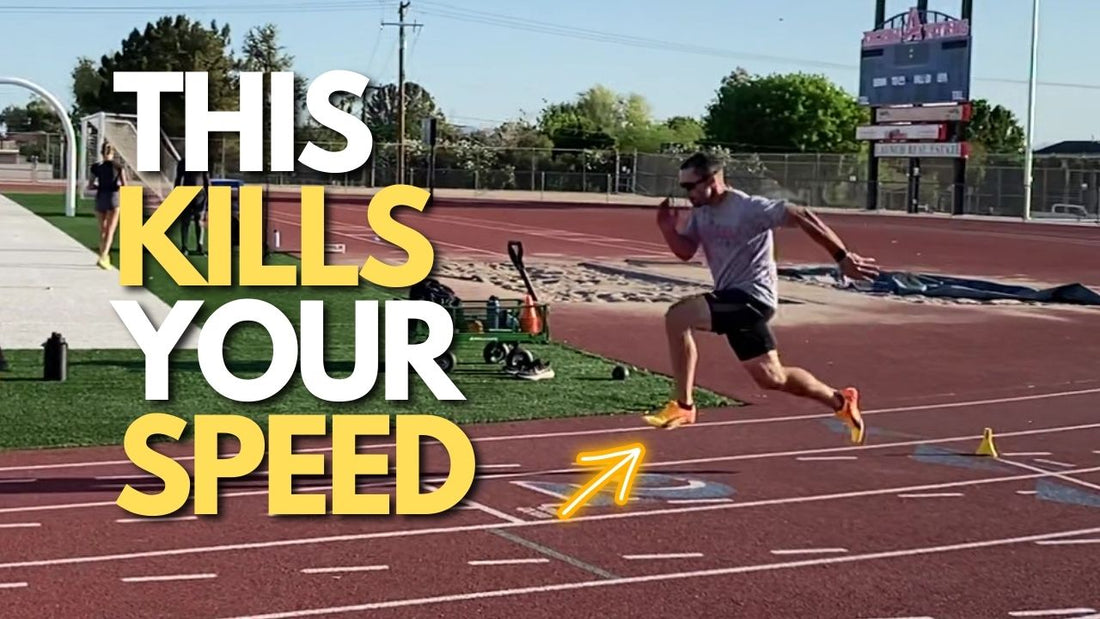In being a sprint coach, there is one common error that I tend to encounter with beginner or developmental sprinters, which holds back their performance and causes injuries.
If you can fix this problem, you will unlock the ability to train more, sprint faster, and become a better athlete, all while minimizing your risk of getting shin splints, or injuries at the ankle, knee, and hip.
In this article, we will discuss how you should apply force to the ground to optimize sprinting technique in an efficient, effective, and safe manner.
Force Production In Sprinting
When we sprint, we need to consider the forces we need to overcome in order to sprint faster.
Gravity is the strongest force we have to deal with, and gravity is directed straight down, pulling us to the earth at an accelerate rate of 9.8 meters per second squared.

Air resistance is also a force we encounter, but this is far smaller in magnitude and generally not a concern unless sprinting in a massive headwind. Air resistance pushes directly back into us when there is no wind.
Another thing to consider is Newton's 2nd law of physics, which states that for every action, there is an equal and opposite reaction.

Considering this information, we can conclude the following:
- To accelerate fast, we must apply force downward and backward into the ground to send our body outward and upward from the the block start.
- As we accelerate, we must continue to apply force straight down into the ground, generate vertical forces that lift us off of the ground and allow us to continue sprinting. Without vertical force application, you will simply be stuck to the ground.
One Of The Biggest Mistakes In Sprinting
Having coached hundreds of developmental sprinters, I have seen that the one of the most common mistakes sprinters make is letting their foot strike the ground while it is moving forward, when they should be setting it straight down or down & back.
When we contact the ground with our foot moving forward at impact, Newton's 2nd law dictates that the sprinter will experience braking forces. If the foot is moving forward into the ground, then ground reaction forces will go into the body in a backward direction, slowing the athlete down each step.

The only way we can accelerate is by producing propulsive forces which are greater than the braking forces of ground contact. Therefore, the direction in which we apply force needs to be appropriate for the stage of the race.
During early acceleration, you should be attacking the ground in a downward and backward direction to launch your body down the track.

As you continue to accelerate and begin to approach maximal velocity, your foot strike needs to be directed straight down, matching the ground speed under you so you can apply large vertical forces to overcome gravity.
Because we have generated forward momentum during acceleration, the goal of the sprinter during upright sprinting is to simply bounce back up into the air with an abrupt vertical application of force, which allows for large forces to be produced in short amounts of time without disrupting the posture or mechanics of the sprinter.
How Can You Develop This Skill In Sprinting?
To learn how to properly direct your foot strike to produce forces properly and avoid injury, you need to focus on what you are doing and how you are moving your body in practice.
You can use sprint drills to practice this skill at a lower velocity, emphasizing an upright posture and a down & back strike into the ground. It is important to note though that just because you can do this in a slow drill does not mean that it will transfer to sprinting.
To develop this skill for sprinting, the only way to really see transfer is for the athlete to be aware of themselves and try to control the movement of the foot into the ground as they sprint. The athlete can try to attack straight down into the ground, or down & back, using slow motion video of the sprint to determine if what the athlete is feeling is being reflected in their sprinting.
